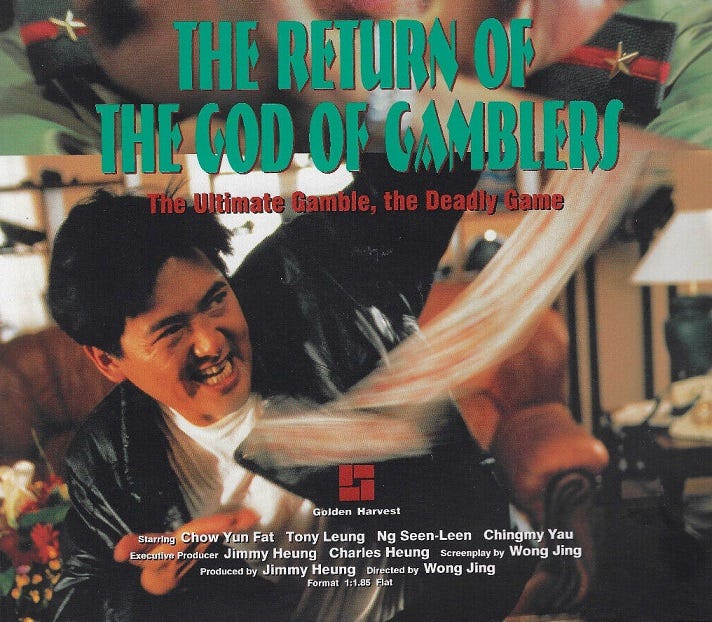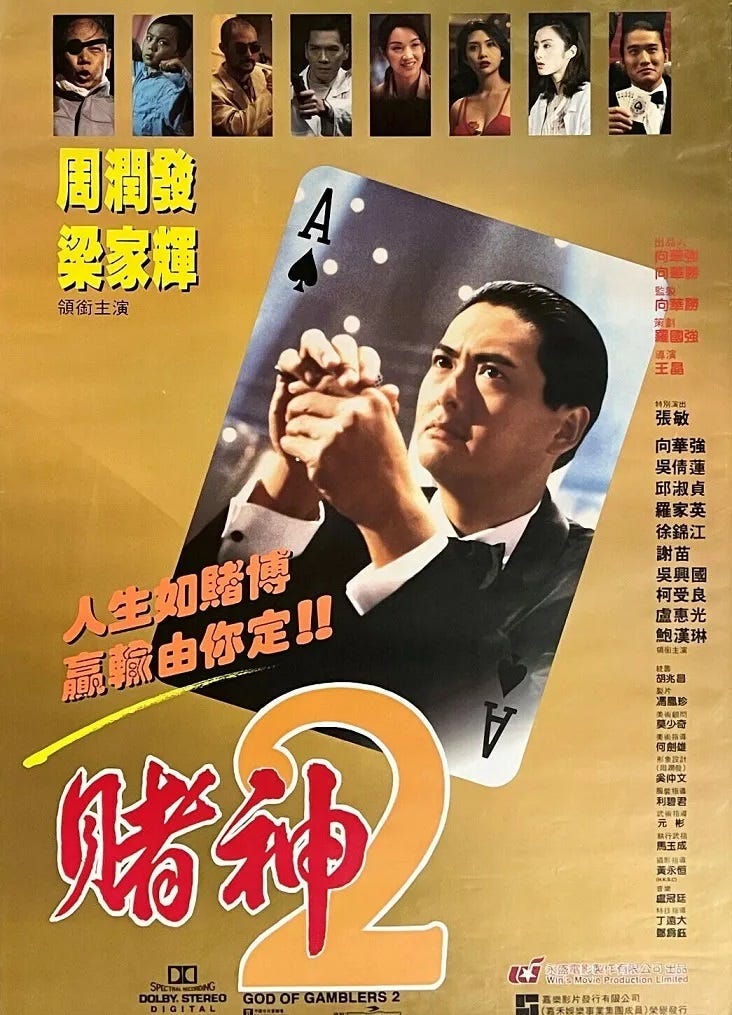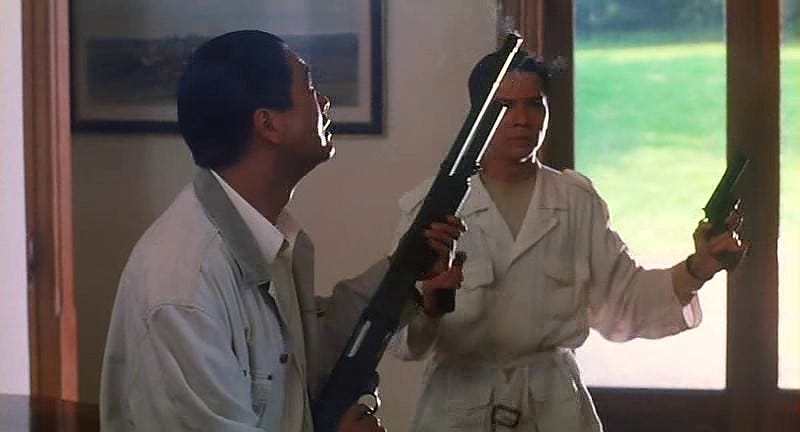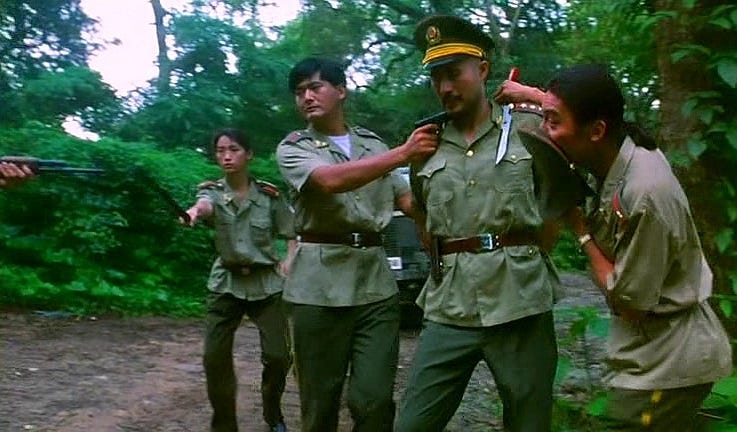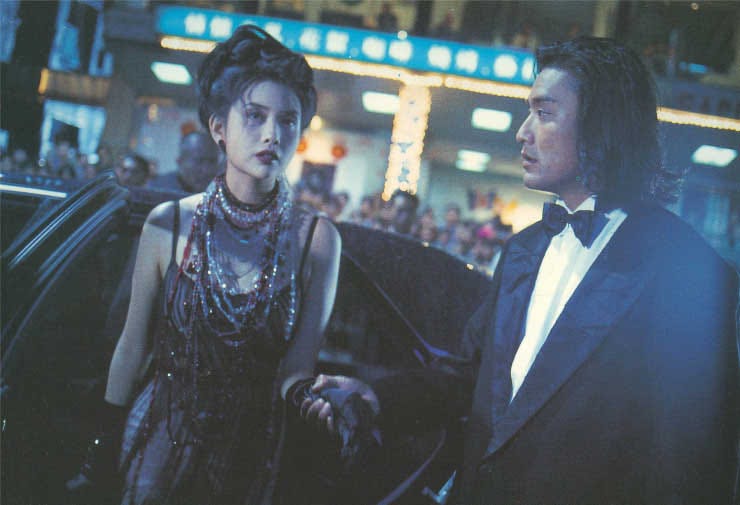Instead of releasing a sequel that was titled God of Gamblers IV: The Return (since it does reference Stephen Chow Sing-Chi’s character in the crossover spin-offs), Wong Jing's first true sequel was supposed to be known in English as God of Gamblers Returns. From part one to part four, Sharla Cheung plays different characters. This could have presented a continuity error, but the anomaly can be easily explained as followed: she plays a twin in the second movie, an apparition in the third movie and a doppelganger in the fourth movie. The only consistent element that ties these four movies together is the casting of Charles Heung as the same bodyguard, who becomes known in the fourth movie as the god of guns. Such casting had only helped to confirm the rumours that Charles was a violent gangster putting on a presentable front in public.
Like an eagle eye lawyer, Wong Jing exploited the use of Roman numerals for the crossover spin-offs i.e. Stephen Chow’s God of Gamblers II (1990) and God of Gamblers III: Back to Shanghai (1991). In England, part four was titled The Return of the God of Gamblers (1994) because the English title on an alternate Hong Kong print had a typo. There is a symbolic dialogue scene in the fourquel. The god of gamblers and the god of guns have made a body-count of the gangsters that they have killed. The number is 22. It's symbolic because it represents the fact that they are in a catch-22 situation. The catch that is awaiting the pair is the sort of unexpected revelation that you wouldn't find in an action comedy, let alone a runaway success at the box office (i.e. local or otherwise). In fact, this movie became the highest-grossing domestic release.
Prior to the shootout, there is a shot of two swans which symbolizes the fact that there is a Chinese term, Er-hong. This means second swan. It sounds like the Chinese term for faded red. This symbolizes a bloody plot twist. In China, swans are actually sometimes known as heavenly geese. This sort of symbolism is reminiscent of John Woo's movies when the doves symbolize the souls of the deceased. Coincidentally, the ancient Egyptians believed that dead people's souls assumed the shapes of birds. Before making God of Gamblers Returns, Wong Jing thought that it was symbolic for Andy Chin’s The Dragon Chronicles: The Maidens and Jackie Chan’s Drunken Master II to have finished their Hong Kong cinema run on the same day that Jeff Lau's Treasure Hunt had.
Andy Chin’s film had a commercial gimmick: leading ladies from Hong Kong, Taiwan and Mainland China. Jackie Chan’s film was his most profitable one in Hong Kong. Jeff Lau’s film was a globe-trotting adventure which had Jacklyn Wu Chien-lien as the sidekick of Chow Yun-Fat, whose character's journey takes him from the U.S. to a Shaolin Temple. Wong Jing then thought back to John Woo's Once a Thief (1991), which began with Chow in France before the movie shifts gears to H.K. for its second half. Since Chow played the titular character of God of Gamblers, Wong Jing felt that the time was right for the people of Hong Kong to see one of their favourite protagonists.
Accordingly, Wong Jing set out to write a screenplay which has the god of gamblers in France for the first reel before shifting the story to Mainland China and Taiwan. Using John Woo as a template was ideal since the first God of Gamblers had similar character development to A Better Tomorrow II where Dean Shek's character goes from normal to insane and back again. Chow Yun-Fat was the star of the A Better Tomorrow trilogy. In Wong's God of Gamblers, it was almost a parody of Woo's sequel when the mentally unhinged character reverts back to normalcy upon seeing his protector wounded in a gunfight. Then again, Wong Jing is one of the most prolific proponents in the field of parody.
The actual name of the gambling god’s bodyguard translates to Dragon Five. Wong Jing’s first real big success at the Hong Kong box office was The Romancing Star - a 1987 movie that combined the star of A Better Tomorrow (1986) with the funniest stars of My Lucky Stars (1985), albeit with Chow Yun-Fat actually replacing matinee idol Charlie Chin Chiang-Lin. “Dragon Five” in Chinese is either Lung Ng (one of the five lucky stars was played by Richard Ng) or Lung Wu e.g. John Woo is known in Chinese as either Wu Yu-Sen or Ng Yu-Sum. This naturally adds another layer to the humour when we see the god of guns firing with two guns at once. While stuffy film critics can’t look beyond Wong Jing’s commercial aspirations and comedic layers, eagle-eyed (or even third-eyed) viewers like myself can tell that God of Gamblers Returns has a lot of hidden meanings.
Like how Hollywood used to depend on the Mainland Chinese market for revenue, Hong Kong used to depend on Taiwan. In fact, so many Hong Kong movies were financed by Taiwanese investors. Both Hong Kong and Taiwan have gangsters who became heavily interwoven within the fabric of their entertainment industries, especially when you have Hong Kong celebrities appearing in Taiwanese productions and vice-versa. Taiwan made more money from Hong Kong movies than the Hong Kong industry because the Taiwanese version of a Hong Kong movie often had more footage. The villain in God of Gamblers Returns is a Taiwanese mafioso. Without giving away the plot, there is an aftermath of a violence which rivals anything concocted by the evil imagination of Japanese filmmaker Takashi Miike.
Like in some martial arts movies that take place in ancient times, the hero is told to not engage in a certain lifestyle and not to reveal his identity. When the story moves from France to Mainland China, it’s fifteen days away from the end of the year. This was a reference to the fact that the movie was going to be released on December 15, 1994. Eventually, the god of gamblers forms a friendship with a boy who he is sworn to protect. The boy is essentially a second son. Their friendship feels like a children’s movie with its goofy humour. One of the things that makes Wong Jing’s movie special is that not only does he combine a children’s movie with a grown-up one, but he cashed in on the popularity of the children’s martial arts genre of Chinese cinema.
God of Gamblers Returns has a lot to say, without being preachy, about the communism of Mainland China versus the capitalism of Taiwan. There’s too much to unload here, so I’m not going to spell out the whole plot for you. You can look online for a synopsis but it’s not the same as watching the movie, and even watching the movie is not the same as knowing about the political relations between Hong Kong, Taiwan and Mainland China. This movie definitely contains a lot of in-jokes. Nationality plays an important part in part four just as it did in part one. But this time, the message is different. Rather than aspiring to be above patrtiotism like in part one, we find that Ko Chun is at times at the mercy of both opposing ideologies. Like in part four, he was a fish out of water in the first movie but under a different set of circumstances. By the way, there is a Taiwanese gangster who worked as both actor and director. His name was Ko Chun-Hsiung. He died in December 2015.
As much as Hong Kong cinema has depicted its fair share of corrupt local police, God of Gamblers Returns depicts the Mainland police as total fascists whereas a Taiwanese double agent is completely unhinged. In this world, no-one is completely normal. Everyone is a victim of something. When the Mainland captain arrives in Taiwan, the first thing that he does is pull some capitalist currency out of his right boot which he confiscated from a Taiwanese hooker who literally sold out in Mainland China. The underlying joke is that you don’t have to sell your body to sell your soul in Taiwan. In part four, it seems like the players in the conflict are caught up in national pride when viewed from afar, but once they are together…everyone gets along. Perhaps the movie would have been stronger had the villain not been Chinese, as if to say that all Chinese should team up against Westerners (especially since this was during a time when Hong Kong was a British colony before the midway point of 1997).




